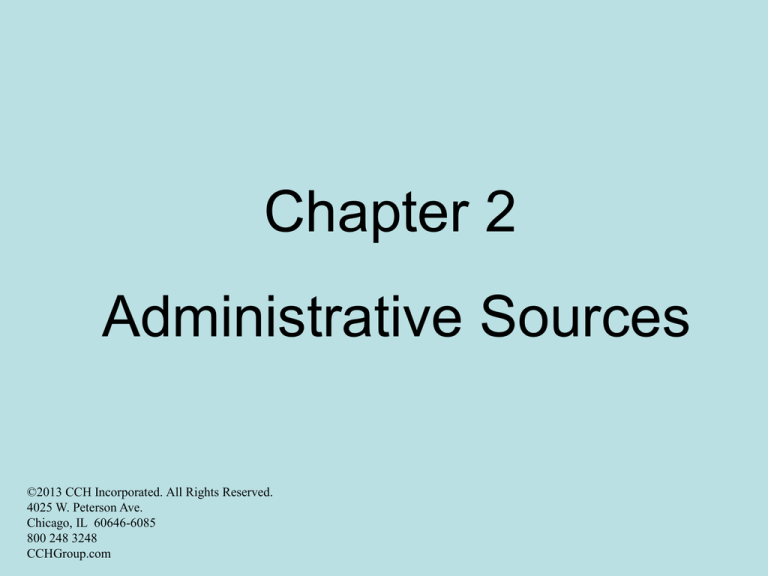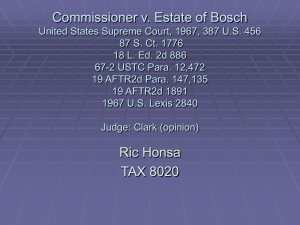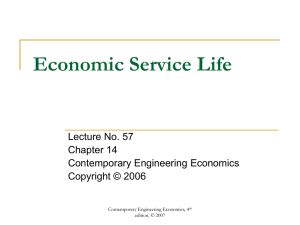
Chapter 2
Administrative Sources
©2013 CCH Incorporated. All Rights Reserved.
4025 W. Peterson Ave.
Chicago, IL 60646-6085
800 248 3248
CCHGroup.com
Administrative Sources of Tax Law
• A Primary source of tax law comes from
Administrative Authorities.
– The Executive branch of the government is
responsible for enforcing the laws created by
Congress.
– The Department of Treasury, part of the
Executive branch, is headed by Secretary of
Treasury, a Presidential cabinet appointee.
• The Treasury is charged with enforcing the
Internal Revenue Code and administering
the tax laws.
Chapter 2
Contemporary Tax Practice
2 of 36
Administrative Sources of Tax Law
(Cont’d)
• Much of this responsibility has been
delegated to a division of the Treasury, the
Internal Revenue Service (IRS), which is
headed by the Commissioner of Revenue
Services (also appointed by President).
–In practice, the IRS handles the daily
administration of the tax law system.
Chapter 2
Contemporary Tax Practice
3 of 36
The Role of the IRS & Pronouncements
• The primary duty of the IRS is to administer the
tax law system.
• In administering the tax law system, the IRS:
– Interprets the Tax Code
– Enforces the tax laws.
– Collects tax liabilities.
• Interpreting the Code
– To help taxpayers determine tax liabilities, the
Service explains and interprets the Code and
other tax laws.
Chapter 2
Contemporary Tax Practice
4 of 36
The Role of the IRS & Pronouncements
(Cont’d)
• Guidance comes through IRS Pronouncements
which constitute the primary source of
Administrative Tax Authority.
– IRS Pronouncements include the following:
• Regulations
• Revenue Rulings
• Revenue Procedures
• Private Letter Ruling
• Technical Advice Memoranda
• Field Service Advice
Chapter 2
Contemporary Tax Practice
5 of 36
Regulations
• Treasury/IRS definitive interpretation of Code
provisions.
– Regulations have the full force and effect of
law – if the interpretation is reasonable and
consistent with the Code.
• Classifications
– Interpretive (majority of regulations) – explain
Code provision.
– Legislative – delegation of authority by
Congress charging the Treasury with the duty
of determining the substantive requirements
for a particular Code Section.
– Procedural - “how to” rules enforce rights and
duties under the tax law.
Chapter 2
Contemporary Tax Practice
6 of 36
Regulations (Cont’d)
• Citing a Regulation
– Reg. Sec. 1.213-1(e)(1)(i) – Prefix is 1 =
Income Tax Regulation, 213 is Code Section
(medical expense deduction), 1 is the first
regulation under this Code Section (e)(1)(i)
are paragraphs and subparagraphs that deal
with definitions, in particular, of medical care.
Chapter 2
Contemporary Tax Practice
7 of 36
Classifying a Regulation?
Section 7701(a)(2) of the IRC defines a “partnership”
for tax law purposes and Section. 7701(a)(3)
defines a “corporation” for tax purposes.
Reg. Sec. 301.7701-2 provides rules for how to
determine whether the taxpayer’s business entity
should be classified as a partnership or an
association taxed as a corporation for tax purposes.
Reg. Sec. 301.7701-3 provides that an entity which is
not classified as a corporation under Reg.
301.7701-2 may elect its tax classification and
provides the manner by which a taxpayer may
make such an election. It also provides default
classification rules for those situations in which the
entity (not classified as a corporation) does not
elect its tax classification.
Chapter 2
Contemporary Tax Practice
8 of 36
Classifying a Regulation? (Cont’d)
Query: This is an example of what type of
regulation?
Answer: Primarily it is procedural because it
provides the rules by which a business entity
may elect its tax classification. It provides rules
for when an election must be made and how the
election is made. The regulation also contains
some substantive provisions as it provides for
default tax classifications for those noncorporate business entities which don’t make an
election.
Chapter 2
Contemporary Tax Practice
9 of 36
Regulations
• How do regulations become law?
– A regulation project is assigned to a task force
by Treasury Dept.
• Attorneys, economists, CPAs in Chief
Counsel’s Office create draft regulations.
– Draft regulations are Proposed Regulations
which are published in the Federal Register
as a Treasury Decision.
• Publication is followed by a 30-day
comment period – comments can be
written or oral.
Chapter 2
Contemporary Tax Practice
10 of 36
Regulations (Cont’d)
• Possible IRS actions after expiration of the
comment period:
–Issue final regulations, withdraw for
further work, no action
• Proposed Regulations are not binding
authority.
̶ Final Regulations published in the Federal
Register have the full force and effect of law.
Chapter 2
Contemporary Tax Practice
11 of 36
Regulations (Cont’d)
– Temporary Regulations, fast-track
regulations, are issued in response to a
recent tax law change or judicial decision.
• 1998 law change required that Temporary
Regulations be simultaneously published
as Proposed regulations
–Which lapse if not finalized within 3
years of issuance.
• While Temporary Regulations are in
existence, they have the full force and
effect of law.
Chapter 2
Contemporary Tax Practice
12 of 36
Revenue Rulings
• Official pronouncements of the IRS’ position with
respect to the application of tax law provision(s)
to a hypothetical set of facts.
• Organization: (1) Issue, (2) Facts, (3) Law, (4)
Analysis, (5) Holding
• Sec. 213(d)(1)(A) defines medical care to
include amounts paid for the diagnosis, cure,
mitigation, prevention of disease or for the
purpose of affecting any structure or function of
the body
Chapter 2
Contemporary Tax Practice
13 of 36
Revenue Rulings (Cont’d)
• Reg. Sec. 1.213-1(e)(1)(ii) indicates that
deductible medical care expenses include
amounts paid for operations or treatments
affecting any portion of the body, but not if the
expenditure is merely beneficial to the general
health of the individual.
• Sec. 213(d)(9) specifically excludes most
cosmetic surgery from deductible medical care,
unless the surgery or procedure is necessary to
ameliorate a deformity arising from, or directly
related to, a congenital abnormality, a personal
injury resulting from an accident or trauma, or
disfiguring disease. (See INDIV: 42,052).
Chapter 2
Contemporary Tax Practice
14 of 36
Revenue Rulings: Example
Query: Taxpayer had breast cancer and was
required to have a mastectomy (most of her
breast tissue was removed). To improve her
mental outlook and her physical appearance,
her physician suggested breast reconstructive
surgery. May taxpayer deduct the cost of her
breast reconstruction surgery?
Chapter 2
Contemporary Tax Practice
15 of 36
Revenue Rulings: Example (Cont’d)
Answer: Rev. Rul. 2003-57, IRB 2003-22.
“Medical care does not include cosmetic
surgery or other similar procedures, unless
the surgery or procedure is necessary to
ameliorate a deformity arising from, or directly
related to, a congenital abnormality, a
personal injury resulting from an accident or
trauma, or a disfiguring disease. Section
213(d)(9)(A). Cosmetic surgery means any
procedure that is directed at improving the
patient's appearance and does not
meaningfully promote the proper function of
the body or prevent or treat illness or disease.
Section 213(d)(9)(B).
Chapter 2
Contemporary Tax Practice
16 of 36
Revenue Rulings: Example (Cont’d)
A's cancer is a disfiguring disease because the
treatment results in the loss of A's breast.
Accordingly, the breast reconstruction surgery
ameliorates a deformity directly related to a
disease and the cost is an expense for
medical care within the meaning of §213(d)
that A may deduct under §213 (subject to the
limitations of that section).”
Chapter 2
Contemporary Tax Practice
17 of 36
Revenue Rulings as Authority
• Taxpayers may rely on a Revenue Ruling, if the facts
of taxpayer’s case are substantially similar to that of
the Ruling.
• The IRS follows Rulings but is not bound by them
(except as to the specific set of facts.)
• Courts (esp. general federal courts, not the Tax Court)
tend to give greater weight to Rulings as authority.
• Published in both – IRB and CB
• Citing Rev. Rulings
– Rev. Rul. 2004-75, 2004-31 IRB 109
– Rev. Rul. 81-122 1981-1 CB 202
– Tax services (CCH, RIA) are an important locator
tool for Rulings
• Tax services will also let you know if the Ruling
has been revoked, revised, modified or limited.
Chapter 2
Contemporary Tax Practice
18 of 36
Revenue Procedures
• The “how to” rules – Statements issued by the
National Office, after review, of the procedures
that affect the rights and obligations of taxpayers
or the general public with respect to the tax law
or which should be a matter of public knowledge
Chapter 2
Contemporary Tax Practice
19 of 36
Revenue Procedures (Cont’d)
– Revenue Procedures are statements of
official IRS positions, and therefore, may be
cited as precedent.
– Published in IRB and CB
• May be located through tax services.
• Citations – Rev. Proc. 2006-49, 2006-47
IRB 936
Chapter 2
Contemporary Tax Practice
20 of 36
Revenue Procedures (Cont’d)
– Examples
• How to file a private letter ruling request?
• How to request a change in accounting
method?
• Update regulations through Rev. Proc. –
changes in standard mileage rate –
business, charitable, medical miles.
Chapter 2
Contemporary Tax Practice
21 of 36
Private Letter Rulings (PLR)
• National Office response to a specific taxpayer’s
inquiry about the interpretation of the tax law as
applied to the taxpayer’s unique set of facts.
• Value as precedent:
– May be relied upon by individual taxpayer
making request (attach to relevant return)
– Generally not considered as precedent by
Service, but
• May be cited as substantial authority to
avoid certain penalties
Chapter 2
Contemporary Tax Practice
22 of 36
Private Letter Rulings (PLR) (Cont’d)
• The IRS and Courts have relied on PLRs
as authority when it helps their analysis.
• Not published, but made available through
Freedom of Information Act (FOIA)
• Citation – pre 2000 – PLR 9046004
post 2000 – PLR 200835025
Chapter 2
Contemporary Tax Practice
23 of 36
Private Letter Rulings (PLRs) (Cont’d)
• How to make a ruling request?
– See first Rev. Proc. of the year, e.g. Rev.
Proc. 2013-1.
– The PLR format is similar to that of Revenue
Rulings: (1) Issue(s), (2) Facts, (3) Applicable
law, (4) Analysis and (5) Holding(s).
Chapter 2
Contemporary Tax Practice
24 of 36
Private Letter Rulings (PLR) Example
• Query? Taxpayer would like to install a pool as
treatment for his back problem. However, he
does not want to incur the expense if the cost is
not deductible as a medical expense. May the
taxpayer request a letter ruling on his proposed
transaction?
• The first Revenue Procedure of the year
provides the requirements for making a ruling
request. However, a Revenue Procedure is also
typically released which states those issues on
which the Service will not issue a private letter
ruling.
Chapter 2
Contemporary Tax Practice
25 of 36
Private Letter Rulings PLR Example
(Cont’d)
• See Rev. Proc. 2013-3, Section 3: Areas in
which Rulings or Determination Letters will not
be issued.
• (26) Section 213. --Medical, Dental, Etc.,
Expenses. --Whether a capital expenditure for
an item that is ordinarily used for personal,
living, or family purposes, such as a swimming
pool, has as its primary purpose the medical
care of the taxpayer or the taxpayer's spouse or
dependent, or is related directly to such medical
care.
Chapter 2
Contemporary Tax Practice
26 of 36
Other Forms of Letter Rulings
• Technical Advice Memoranda (TAMs)
– IRS letter ruling issued in response to a
request from a District Director or Appeals
Officer for an answer to a technical question
that arises during an audit
• Taxpayer specific, therefore, not generally
authoritative as precedent, although may
be relied upon by IRS and courts as a
statement of position.
Chapter 2
Contemporary Tax Practice
27 of 36
Other Forms of Letter Rulings (Cont’d)
• Field Service Advices (FSAs)
– National Office advice to IRS agents,
Attorneys, or Appeals Officers who seek
advice on how to treat a developing issue or
on the hazards of litigating a particular issue
• Again not generally authoritative, although
may be relied upon by Service and courts
as a statement of position.
Chapter 2
Contemporary Tax Practice
28 of 36
Other Forms of Letter Rulings (Cont’d)
• Determination Letters
– District Director’s response to a request for
the tax consequences of a specific taxpayer
transaction, for example, Is this pension plan
we set up a qualified plan?
• Only applicable to taxpayer making request
Note: TAMs, FSAs, Determination Letters – not
published by IRS, but made available to
public through FOIA
– Best source to locate these releases – tax
services.
Chapter 2
Contemporary Tax Practice
29 of 36
Miscellaneous Technical Guidance
• Announcements and Notices
– Quick notice to public
• Often issued as a precursor to an official
release, such as a Ruling, Procedure or
Regulations.
• Published in IRB and CB
• General Counsel Memoranda (GCM)
– Response of Chief Counsel’s office to an
internal request for legal analysis to be used
in a Revenue Ruling, PLR, or TAM.
Chapter 2
Contemporary Tax Practice
30 of 36
Miscellaneous Technical Guidance
(Cont’d)
• Technical Memoranda (TM)
– Transmittal letter from Commissioner of IRS to Asst.
Secretary of Treasury for Tax Policy explaining Final
Regulations. (Information now contained in Preamble
to Final Regulations.)
• Action on Decision
– Chief Counsel’s response to a court decision which is
adverse to an IRS position – what should the Service
do?
• Acquiesce (follow the decision), not acquiesce
(don’t follow the decision except as to specific
taxpayer), do nothing.
• Internal Revenue Manual
– Policies, procedures and guidelines governing the
operations and organization of the IRS.
Chapter 2
Contemporary Tax Practice
31 of 36
Additional IRS Releases
• Informational Releases
– Information Letters – National or District Office letters in response
to a taxpayer request for guidance that point the taxpayer to a
well-established interpretation of the Code.
– Technical Information Releases (TIRs) – notice of a technical
development that must be acted upon quickly.
– News Releases – items of general interest.
• Audit Related Releases
– Closing Agreements – agreement between the Service and a
taxpayer regarding a particular tax issue or liability.
– Audit No-change Letter – a letter to a taxpayer that audit will not
result in change to taxpayer’s liability.
Chapter 2
Contemporary Tax Practice
32 of 36
Additional IRS Releases (Cont’d)
• Compliance-Related Releases
– Publications – self-help booklets with general
tax information organized in a topical manner.
– Instructions to Tax Forms – “how to” fill out
forms
Chapter 2
Contemporary Tax Practice
33 of 36
Additional Releases – Value as
Precedent
Query: To what extent do these various
additional informational and IRS technical
releases constitute legally binding authority
that may be relied upon by taxpayers and
practitioners and bind the Service? Why?
Answer: These IRS releases do not constitute
binding authority to be relied upon by
taxpayers and tax practitioners. This is
because of their nature and character.
Chapter 2
Contemporary Tax Practice
34 of 36
Additional Releases – Value as
Precedent (Cont’d)
Audit releases, for example, relate only to the
audit process at hand. Thus, they are limited
in application to the specific taxpayer for the
specific tax year. Informational releases and
compliance related releases provide general
information or general guidelines about the
application of the tax law without reference to
specific fact scenarios. Without reference to
facts general advice about the tax law is not
binding. As we know, the outcome of the
application of the tax law can be changed by
subtle variation in facts. Recall the two
cardinal rules of tax research – (1) know the
facts, (2) read the Code..
Chapter 2
Contemporary Tax Practice
35 of 36
Additional Releases – Value as
Precedent (Cont’d)
With respect to the technical releases, they also
do not constitute binding legal authority. This
is because releases such as General Counsel
Memoranda, Action on Decision and the
Internal Revenue Manual are documents
generated for internal use. Although not
legally binding, however, they may certainly
provide useful inside information indicating
the official IRS stance on a specific matter.
Chapter 2
Contemporary Tax Practice
36 of 36









